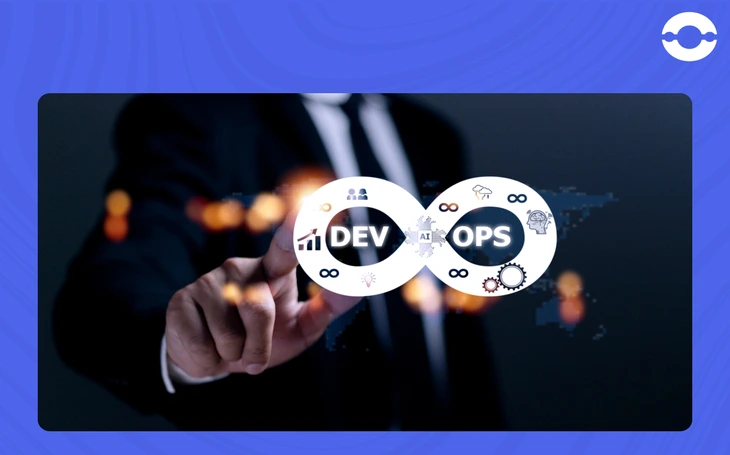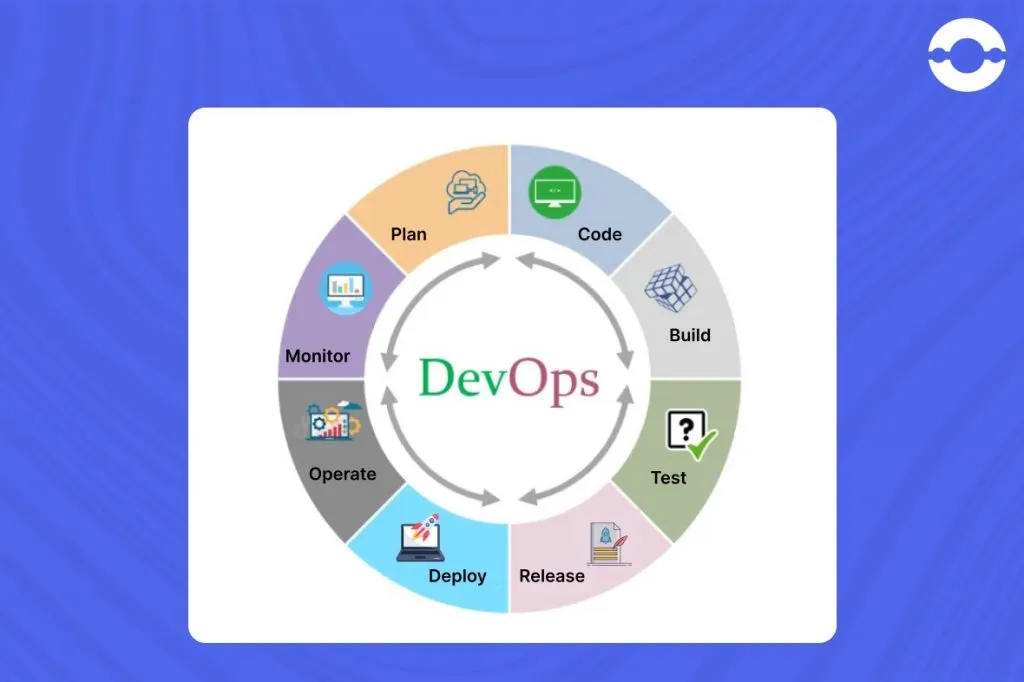
Adopting DevOps methodology might seem like a new buzzword for many of you. It comes from 2 words- Development and operations.
DevOps is not a tool; it is not a programming language or software. It is the philosophy that transforms how businesses deliver their products to millions of people.
DevOps is a mindset that completely changes how an organization can perform software processes. In this guide, we will explore in detail what DevOps is and its methodology.
What Is DevOps?
DevOps is the combination of Development and operations, representing a collaborative approach between various team members.
The prime motto of DevOps is to deliver fast applications to customers, which is not possible in traditional development processes.
When you are designing a midsize app, 2 teams are generally involved:
On one hand, there is a development team that includes developers who have expertise in writing code, creating designs, and testing features.
On the contrary, there is another team called the operations team, which handles the server configurations and analyzes things such as do they need to integrate cloud servers or not.
The concept of DevOps methodology is there to solve this problem, where the development and operations teams sit together and understand each other’s roles and responsibilities.
In a nutshell, the development team knows what’s happening in operations, and the operations team knows how the development team is working.

Need of DevOps
In the traditional waterfall model, software development occurs in sequential stages, from gathering requirements, design, Development, deployment, testing, and maintenance. Everything was performed sequentially as it is a top-down approach.
However, the disadvantage was that developing software takes a lot of time and effort.
But the waterfall model is not adaptable to changes in project requirements. Hence, it lacks flexibility.
Then, there is an agile model where the project is divided into smaller chunks.
For example – The developer wants to provide 100 functionalities to the client. They split 20 functionalities in each iteration which will be delivered to the customer. However, the agile model adapts to the changes in customer requirements and is far better than the waterfall model.
However, as Development and testing are performed simultaneously in this model, there is usually a gap between operations and Development.
Hence, the DevOps concept existed for better collaboration between development and operations teams. Thus, by adopting DevOps practices in an organization, software delivery becomes fast, and quality has improved significantly.
In addition, DevOps uses Continuous Development, Continuous Integration, and continuous testing in the development processes, to build, test, and deploy the app automatically.
Hence, an organization can manage its software development cycle from Development to deployment.
How Does DevOps Work?

1. Planning
This stage involves understanding the project’s requirements, goals, and objectives. So, The DevOps team creates an entire project roadmap to produce the desired result.
2. Code
The developers write code as per the project specifications, as discussed in the planning phase. While The development team makes use of DevOps tools to streamline the development process. Additionally, the development team ensures that the code developed should be scalable and maintainable.
3. Build
After completing the development task, the developer submits the code to the shared code repository. Furthermore, the developers pass a request to merge new code with the shared code repository. This new code would be open for review by fellow developers.
4. Test
The Q/A testing team would conduct various tests on the product to ensure that the product delivered is as per planned project objectives. Various testing tools are used to check the performance of the product.
Here, Developers perform performance and user acceptance tests to ensure the product is of high quality.
5. Release
After testing the build, it’s time for the operation team to deploy the product to the production environment.
6. Deploy
Now, the code is ready to be deployed on all servers. The tested/ validated code will be released in the production environment.
7. Operate
The software/application is readily available to customers. The operations department of an organization manages configurations.
In this step, the organization takes customer feedback because customers are the real testers who would be using the application in their day-to-day processes.
8. Monitor
The development team monitors the DevOps pipeline based on customer feedback, analyzing an application’s performance, etc.
Developers can further use this feedback for identifying loopholes in the development process that might affect the performance of an application. For Instance – The development team can collect feedback from end users who might be using the software.
Tools Used In DevOps
Here are the 4 tools used in DevOps –
1. Jenkins (Continuous Integration & Continuous Delivery)
Jenkins is one of the popular DevOps tools that developers use for continuous delivery and continuous Integration that involves building, testing, and deploying.
This DevOps tool is an open-source Java application for automating software development processes. Furthermore, This tool could work on multiple operating systems like Windows and OS.
Jenkins has more than 2000 plugins and developers can deploy it on cloud platforms. Jenkin tool offers developers access to a wide range of integrations and tools, all with a simple installation.
2. Prometheus (Continuous Monitoring)
The Prometheus tool is another tool that the DevOps manager uses for continuously monitoring the application. This software is used for recording metrics in real-time. Metrics means numerical measurements such as request time for database or active connections.
The Prometheus tool displays numeric information to help developers monitor an application’s performance. Furthermore, It provides access to reporting tools through a dashboard where data is displayed in a visual format.
For example – If your application is running slow, and as a developer, you want to find the exact cause of why the application is not performing well. Then, the Prometheus DevOps tool could help you by displaying information in visualized format.
3. Git (Continuous Development)
Git is the distributed version control tool for managing different source code versions. It has provided ease to developers to do an effective collaboration.
85-95% of companies use Git for collaboration among team members. Additionally, It is an effective tool for evaluating where the developer can collaborate and assess the changes.
Additionally, it allows you to track the status of your development work. The Git DevOps tool makes an easy collaboration between development and operations teams.
4. Docker (Continuous Deployment)
DOCKER is a DevOps tool to create, deploy and run apps using containers. Whenever a developer develops a product, there are certain issues.
The application runs smoothly in the developer machine, but when it is moved to the production stage or deployed on a server, then it’s not working. It leads to a debate between the developer and the operations team.
Docker is compatible with any project or programming language. Moreover, Docker comprises containers and allows the developers to build your application in containers and deploy these containers on any machine.
Wrapping up
Now, you might better understand the DevOps methodology, how it works, and the best tools you can use for your next development project.
As most organizations are switching to cloud architecture, there is a need for better approaches like DevOps so that development and operations teams can work smoothly.
As a certified DevOps consulting company, we adopt the best CI/CD practices and use automation tools to speed up the software development cycle and design better products.
If you’re struggling with legacy-based infrastructure, we can conduct a detailed strategy session which starts with –
- Analyzing your existing tech stack infrastructure,
- finding the loopholes and
- then creating a customized plan that helps you perform faster software releases.
FAQs
DevOps methodology comprises 8 steps –
1. Planning
2. Code
3. Build
4. Test
5. Release
6. Deploy
7. Operate
8. Monitor
Agile, ITIL, LEAN, and SRE are four popular DevOps framework models.
1. Agile methodologies such as Kanban and Scrum are iterative frameworks that rely on continuous feedback from customers to improve efficiency.
2. LEAN is a framework for identifying waste throughout the process and improving efficiency to streamline it.
3. ITIL (Information Technology Infrastructure Library) is a framework for implementing best practices in information technology such as incident management, release management, and change management.
4. SRE (site reliability) is a framework for ensuring that a site is reliable, stable, and always up and running.
DevOps is a practice that requires the use of various tools, such as Jennikens, Gitlab, and Github, as well as linting tools like SonarQube, Kaban, and Grafana, to improve the software development lifecycle.
Python is the popular programming language for DevOps. Also, is easy for beginners to become proficient in this language. Additionally, Developers who have expertise in Python can perform various tasks in DevOps.
1. If your organization wants to do frequent software releases, then DevOps is not a good choice for you.
2. If your organization does not have skilled personnel proficient in DevOps, then DevOps is not a profitable option for you.
3. Your business is comfortable with using traditional software development models because there are no business requirements.
4 Comments
Cristian Mccall
July 15, 2023Awesome! Its genuinely remarkable post, I have got much clear idea regarding from this post
Solomon Gonzalez
July 24, 2023I just like the helpful information you provide in your articles
Magazyny Energii
July 25, 2023Thank you for this helpful post! Your tips and insights have made a positive impact on my understanding of the topic. Keep up the great work!





cnn united kingdom
June 19, 2023Pretty! This has been a really wonderful post. Many thanks for providing these details.